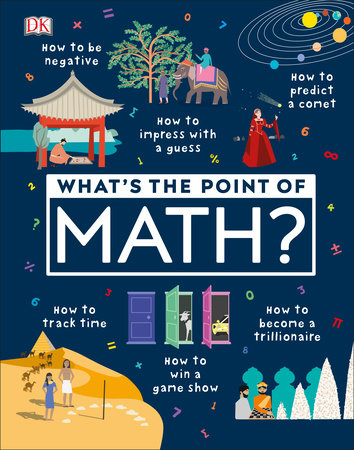STEM Tuesday– Math– In the Classroom

What’s the story of math? It’s more than logical equations, patterns, and exact answers. These STEM Tuesday books tell of math’s history, its use, and how it integrates into the lives of fictional characters. Bring the story of math into the classroom with these fun activities.
A Quick History of Math 
by Clive Gifford, illustrated by Michael Young
This book chronicles the history of math, beginning with the Lebombo bone (the very first mathematical object in the world) all the way to the present day. Readers will learn how to count like an Egyptian using hieroglyphs and how to do matha-magic with magic squares. It’s fun and engaging, and also packed with jokes, graphics, and activities.
Classroom activity: Reenact the history of math with micro-performances in the classroom. Have students research a moment of math history from the book. Then ask them to create a little skit to act out that moment. Some examples could be:
- An Ancient Egyptian store where the cashier adds up purchases using heiroglyphs
- Be a Babylonian math teacher and teach the class to add
- Host a Chinese magic squares game show
- Stage a short counting story play using Mayan math
Encourage students to create visuals, add math jokes, and interact with their audience. See how creative they can be!
What’s the Point of Math?
by DK
What’s the Point of Math? not only highlights how math is all around us, but also,that math is fun. Through a slew of fun facts, magic tricks, and mathematical brainteasers, readers will be entertained while they learn. The book also touches on the history of math as well as bios of famous mathematicians.
Classroom activity: Pick a famous mathematician from the book to write about. Have students research their mathematician and write a short biography of that person. Ask them to find photos or images to go along with parts of their bios. Encourage students to write interesting hooks at the beginning of their bios and titles for their biographies.

Much Ado about Baseball
by Rajani Larocca
Although this is fiction, Much Ado about Baseball is a stellar book. To be clear, it doesn’t specifically teach readers about mathematical concepts, but the narrative connects to math in many ways. For example, twelve-year-old protagonist Trish is able to solve tough math problems and loves baseball. When she moves and joins a new baseball team, they must solve a difficult puzzle or there will be tragic consequences.
Classroom activity: Part of writing fiction is developing characters. Ask students to develop a math-loving character. They should write descriptions of the character and how math is part of their lives. Pose these prompts: What kind of personality does this person have? What do they look like? What kind of math goals do they have? What are their strengths and weaknesses? Have students create posters with an image of their character, their character’s name, and a description of what they are like.

Karen Latchana Kenney loves to write books about animals, and looks for them wherever she goes—from leafcutter ants trailing through the Amazon rain forest in Guyana, where she was born, to puffins in cliff-side burrows on the Irish island of Skellig Michael. She especially enjoys creating books about nature, biodiversity, conservation, and groundbreaking scientific discoveries—but also writes about civil rights, astronomy, historical moments, and many other topics. Visit her at https://latchanakenney.wordpress.com
The post STEM Tuesday– Math– In the Classroom appeared first on From The Mixed Up Files.

